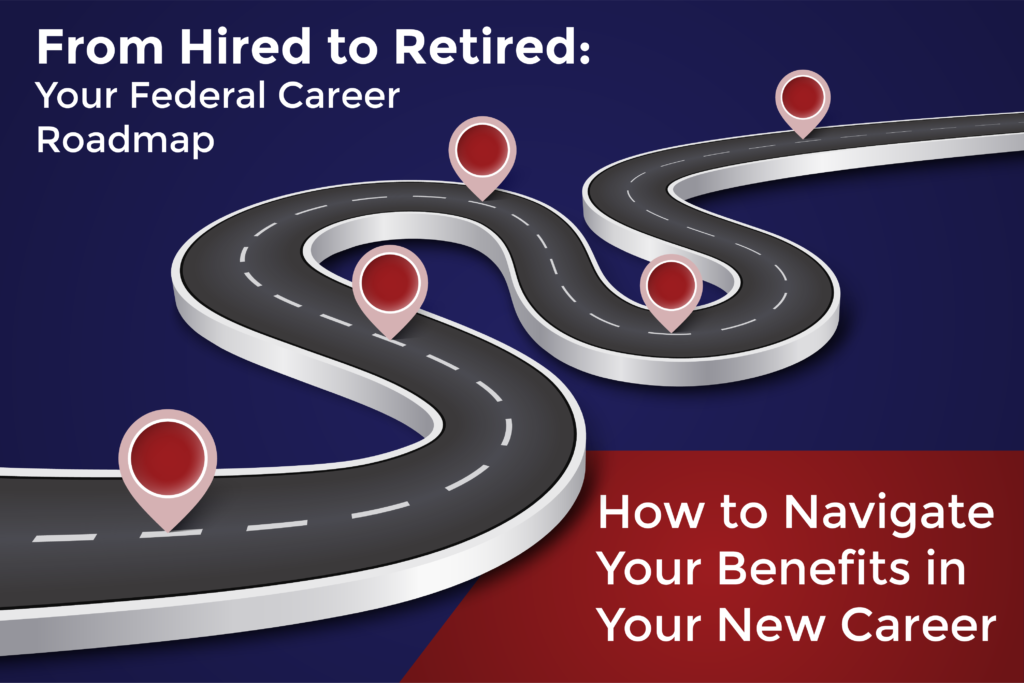From Hired to Retired: Your Federal Career Roadmap
How to Navigate Benefits in Your New Career
When you begin a new career, you have several decisions that need to be made regarding your benefit. Oftentimes, these decisions can have a huge impact on your future. In this post, we’ll discuss various benefits options and how to position yourself for a successful future.
Whether you are just starting or have a few years under your belt, this article will be a great refresher on coverage gaps, short-term disability, life insurance, and planning for retirement.
Protecting Your Income Through Leave and Short-Term Disability
Each year, a full-time employee will earn 13 days of annual leave. Due to the annual leave cap, you are only allowed to carry over 30 days of annual leave year to year. You’ll also earn 13 days of sick leave and can carry over 30 days of sick leave year to year. This paid time off takes a long time to earn but is quick to burn – if you have to miss work, you could end up using all of the paid time off that you spent YEARS accruing in just eight short weeks.
A short-term disability policy covers medical absences from work that are expected to last more than two weeks but less than one year. If you cannot work due to an accident or illness, your short-term policy would pay you a monthly benefit of up to 60-70% of your gross salary (depending on state law). You decide the level of coverage you would like, and premiums can be payroll-deducted with a United Benefits plan. Benefits are paid directly to you tax-free and can be coordinated with any sick or annual leave you have accrued.
Federal Employee’s Health Benefits (FEHB) Options
When you choose your health insurance, you’ll be considering the cost, whether you want an HMO or a PPO, how high the deductible is, whether you’ll be paying copays (a fixed dollar amount) or coinsurance (a percentage of the cost that is billed to the insurance company), and what your maximum out-of-pocket is. Each open season you’ll have the chance to review any changes to your plan and choose a new plan or stick with the one you have.
At the beginning of your career, you may not be using your healthcare insurance as often as you will when you are older. In this case, a Health Savings Account (HSA) is a great way to take advantage of tax benefits – money that goes into your HSA reduces your taxable income, the investment growth is tax-free, and using the money for qualified expenses is also tax-free.
Choosing the best plan for you and your family may also mean that you choose a plan that has coverage gaps. Other supplemental insurance is available to cover those gaps. For example, if you know you will be using your health insurance to cover a planned pregnancy but you have a high deductible or coinsurance on inpatient stays, you could add hospital indemnity coverage and use those payouts to cover whatever you have to pay out-of-pocket.
How to Choose Your FEGLI Options Efficiently
Federal Employee’s Group Life Insurance is term life insurance. You are auto-enrolled into the Basic plan when you are hired. You then have 60 days to make changes to your coverage. After that, only a qualifying life event (such as getting married or the birth of a child) or a FEGLI open season (which happens every 7-12 years) will qualify you to make changes.
One option is to pair the Basic plan with a whole life policy so that you can keep coverage into retirement. Generally, life insurance only pays out when you die. However, whole life insurance also offers living benefits so that your policy can help you while you are still alive in the case of chronic illness.
Another option would be to have a simple 30-year term life insurance policy instead of taking Option B on your FEGLI life insurance. The cost savings could be in the tens of thousands of dollars.
United Benefits offers life insurance plans that are individually owned, available post-retirement, don’t require physicals, and are affordable alternatives to FEGLI.
The Most Significant Impact on Your Future Retirement
The Thrift Savings Plan (TSP) is one of the biggest factors that play into how much money you’ll have when you retire. The TSP is tax-deferred and offers automatic payroll deduction. The agency offers 5% matching as well, which is a terrific return on that money.
When you put money into your TSP you’ll choose which funds you want to invest in. You can invest your money in funds that are safer or riskier depending on your level of risk tolerance and what year you plan on retiring. United Benefits Retirement Specialists can talk to you about each fund and which ones may be the right choice for you.
Tips for New Employees from Retirees
- Insure your paycheck. Accidents happen, and supplemental insurance can ensure that your paycheck is protected in case you have to miss work.
- Make your life insurance decisions EARLY. The younger you are, the cheaper life insurance will be. Protecting your family in the event you pass away unexpectedly can be done in an efficient manner.
- Start investing in your TSP as soon as possible – today is the best day to start. Take advantage of the power of compound interest and time to multiply your savings.
- Choose your TSP funds wisely. Diversify your investments and invest in more aggressive funds when you have time to ride out the changes and invest in less risky funds when you are closer to retirement.
- Contribute what you can afford into your TSP – paying yourself first will pay off when it comes to retirement. You’ll be able to have a stable, solid income when you are ready to retire.

